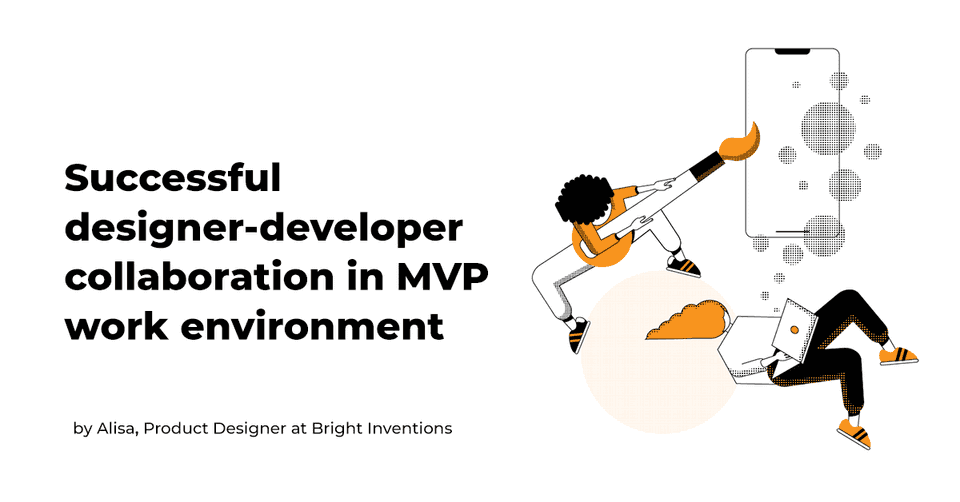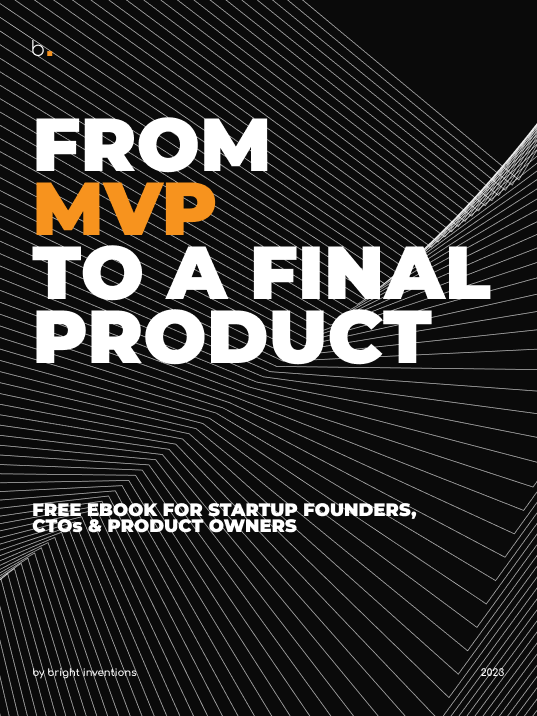Successful Designer-Developer Collaboration in MVP Work Environment
Undertaking a brand new idea and turning it into a successful product is always thrilling but also risky. In order to create a successful and meaningful project it is essential first to build Minimum Viable Product (MVP) to see if we are on the right track and if our strategy is going in the right direction. That is why, building MVP gives us an advantage, as it helps define all possible pitfalls, eliminates gaps in a wholesome product in future, or even helps to understand if our approach should be changed completely already on the early stage of the project.

Hence, the work environment of MVP should be highly lean and flexible, the collaboration of the team inside such environment should also resemble all traits of resilience, an ability to adapt to a constant change at a rapid pace. Thus, a favourable outcome of MVP largely depends on the team, the way they communicate, adapt and collaborate with each other. Especially, when it comes to designer-developer joining forces, it is essential that they create a work tandem and do their best to achieve top results. How do we make sure that the designer-developer team work is lucrative?
Here are 3 easy tips to a successful collaboration in MVP environment:
Listen
Listen with the intent to understand, not with the intent to reply
Stephen R. Covey in his book, The 7 Habits of Highly Effective People: Powerful Lessons in Personal Change has stated that most of us do not really listen in order to understand, as when our interlocutor explains their idea we do not listen till the end of their sentence, at the very moment we are preparing our reply and we are thinking of what we want to tell our interlocutor. This way we are focusing on what we want to say, not hearing the other party.
Most people do not listen with the intent to understand; they listen with the intent to reply.
Whether you are a designer or a developer, make sure you always listen to the other party and what they have to communicate. While building MVP some adjustments and modifications are inevitable. Developers will most likely ask for a few changes in the designs to make a project easier and faster to implement.
Certainly, in the real MVP environment designs might be altered, oftentimes projects will not be even done pixel perfect. A few components can look a little different, as for the faster development ready-made solutions might be taken into consideration as long as they do not disrupt the usability.
On the contrary, in some cases it might not be possible to simplify and cut down on a number of things while these changes might hurt user experience or the design system of the product. So, listen in order to hear these arguments from both sides because MVP may not be pixel-perfect, but it should be pleasant and easy to use.
Ask
There are no stupid questions in a positive environment
Positive atmosphere enhances productivity. Usually building MVP requires a high paced working process which might ricochet at team with stress and feeling pressure especially before meeting the deadlines. What can be worse than confusion and misconception while trying to work fast? Any misunderstanding increases tension in working relations and slows down the process.
Therefore, it is significant to ensure that the designer and developer teams are working in a friendly environment, are positive and respectful towards each other and are comfortable with asking questions, which discards misunderstandings and results in delivering product faster and with less stress.
Asking questions might not be that easy for everyone. Some people hesitate to acknowledge that they do not understand something in order not to be perceived as someone who slows down the working process with their questions. Nevertheless, asking the right question at the right moment might expose the problem from a different perspective and show that the initial concept was not right and the change is needed.
That is why it is important to maintain positive working relations in which there are no stupid questions, as raising queries can eliminate misunderstandings, lead to discussions and delivery of better MVP. So, don’t be afraid of asking questions and do not hesitate to answer the same questions again and again till the mutual understanding is reached.
Adjust
MVP is about adopting to a change
Building MVP means to be constantly ready for a change. Successful MVPs use a User-Centered Design approach which follows user needs on all stages of the project. That includes some frequent user testing sessions that help understand if the features we design and build are really needed and if user appreciates them. After such user testing, most often, the product requires some adjustments.
At times these changes do not only result in making buttons more eminent, but even in giving up one feature in favour of another, or so much as rethinking the whole concept. So, designer-developer tandem should be ready as for small modifications, as well as for bigger conceptual alterations of the product.
Dive into MVP development with our guide

In conclusion
Undoubtedly, as designer-developer being a part of MVP process is an amazing experience as you get to see the birth of a product and provide the ideas which can change it. You also can learn volumes from the user feedback, make small adjustments, or rethink the whole concept of an output.
However, the success of MVP also depends on the designer-developer ability to cooperate with each other. Remember not only to listen to the other party but also hear what that party has to say. Don’t be afraid of asking questions, and don’t be reluctant to answer the same questions again and again.
And particularly, do not get attached to already created solutions, be prepared to frequent changes, modifications and alterations. Trying to follow these tips may bring you and your team to a positive, friendly MVP working environment.
Contact us if you are looking for MVP development agency. We are ready to help!
